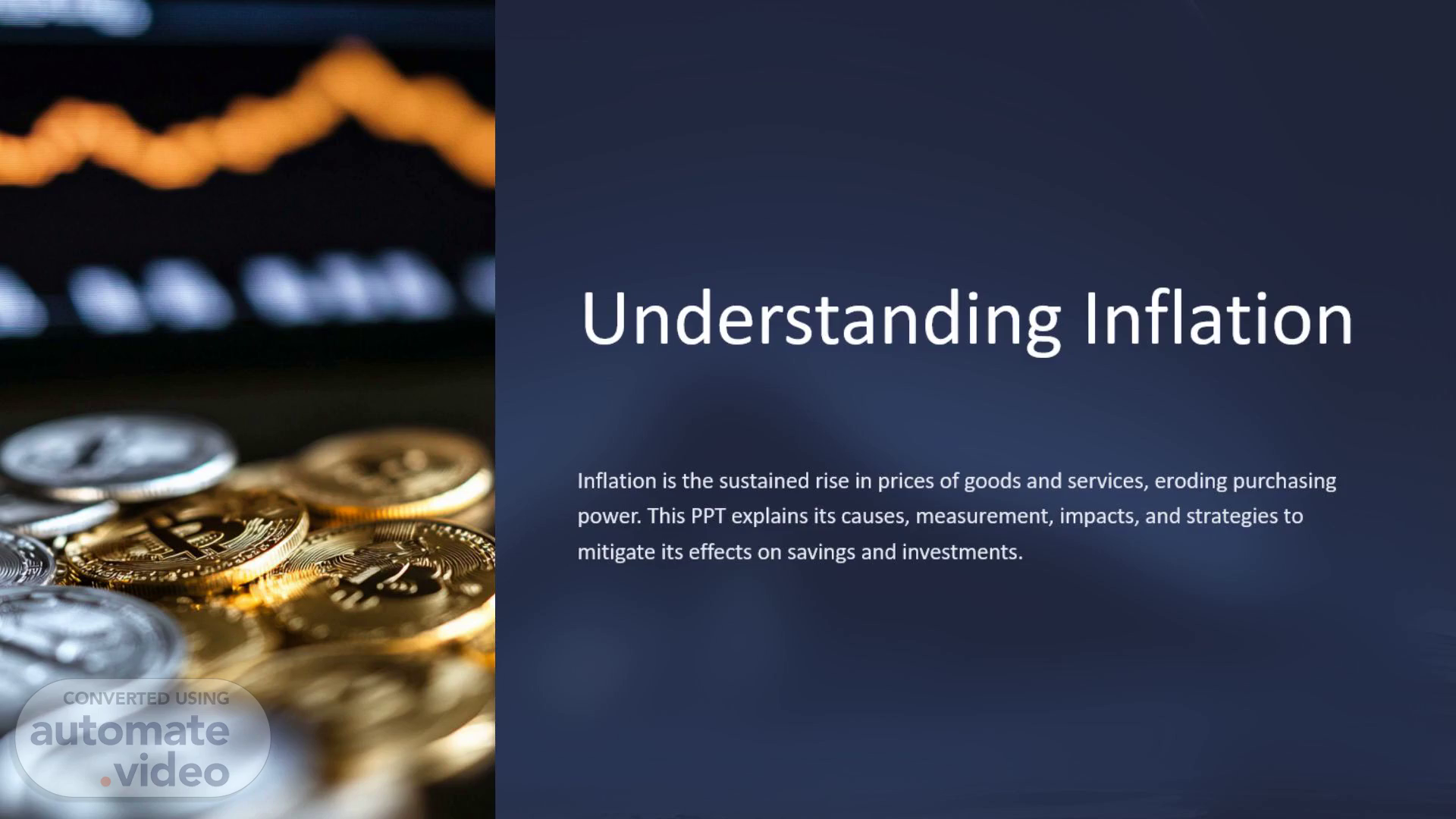Scene 1 (0s)
[Audio] Understanding Inflation Inflation is the sustained rise in prices of goods and services, eroding purchasing power. This PPT explains its causes, measurement, impacts, and strategies to mitigate its effects on savings and investments..
Scene 2 (18s)
[Audio] What is Inflation? Definition Inflation is the general increase in prices over time, reducing the value of money. A unit of currency buys fewer goods/services as inflation rises. Scope It reflects economy-wide price hikes, not just specific items. For example, ₹100 today may buy less than it did a year ago. Key Effect Inflation diminishes purchasing power, altering consumption and saving behaviors..
Scene 3 (59s)
[Audio] Measuring Inflation Core Inflation WPI CPI Tracks price changes for a urban consumer basket (e.g., food, housing). Reflects everyday cost of living. Measures wholesale price shifts, impacting production costs before retail. Excludes volatile items (food/fuel) to reveal long-term trends..
Scene 4 (1m 30s)
[Audio] Causes of Inflation Cost-Push Inflation Rising production costs (e.g., oil prices) force businesses to raise prices. Demand-Pull Inflation Occurs when demand exceeds supply (e.g., post-pandemic spending surges). Built-In Inflation Wage-price spiral—higher wages lead to higher prices, perpetuating inflation..
Scene 5 (2m 36s)
[Audio] Value of Money Real vs. Nominal Erosion Nominal income ignores inflation; real income adjusts for it. A 5% raise with 7% inflation means a 2% loss. ₹100 buys fewer items yearly (e.g., 10 → 8 items)..
Scene 6 (3m 8s)
[Audio] Impact on Savings Long-Term Effect Negative Returns Savings yielding 4% during 6% inflation lose 2% in value annually. Over decades, unchecked inflation can halve savings’ purchasing power..
Scene 7 (3m 54s)
[Audio] Impact on Investments Stocks/Real Estate Inflation Bonds Low-Yield Risks Fixed deposits below inflation rates erode real wealth. Often outpace inflation, preserving wealth. Like India’s Inflation-Indexed Bonds, adjust returns for inflation..
Scene 8 (4m 47s)
[Audio] Daily Expenses Utilities/Rent Recurring costs increase, reducing disposable income. Groceries/Fuel Prices rise fastest, squeezing budgets. Transportation Higher fuel prices cascade into service fees (e.g., Uber)..
Scene 9 (5m 9s)
[Audio] Protecting Against Inflation Diversify Inflation Bonds Budget Adjustments Safeguard returns via government-backed securities. Prioritize needs over wants to counter rising costs. Mix stocks, real estate, and commodities..
Scene 10 (5m 32s)
[Audio] Learning Activities Simulation Game Mock budgets with inflation stress-test financial planning. Price Comparison News Analysis Compare 2015 vs. 2025 prices (e.g., milk: ₹40 → ₹65). Link headlines (e.g., oil prices) to inflation theories..
Scene 11 (5m 55s)
[Audio] Types of Inflation Inflation can be categorized into different types based on its intensity and impact on the economy. Creeping inflation is mild and supports growth, while galloping inflation disrupts economies. Hyperinflation renders currency worthless, and deflation involves falling prices that hinder economic growth. Galloping (10-100%) Creeping (0-3%) Disrupts economies (e.g., India’s 1970s). Mild, supports growth. Hyperinflation (1000%+) Deflation Renders currency worthless (Zimbabwe). Falling prices hinder growth (e.g., Japan)..
Scene 12 (6m 47s)
[Audio] Winners & Losers Winners Borrowers (repay cheaper debt); asset owners (real estate appreciates). Losers Fixed-income earners (pensions); savers (low-interest accounts)..
Scene 13 (7m 10s)
[Audio] Stagflation Stagflation is a rare economic condition characterized by high inflation, high unemployment, and stagnant demand, presenting a significant challenge for policymakers. Rare Crisis Policy Dilemma Fixing inflation may worsen job losses High inflation + unemployment + stagnant demand (e.g., 1970s USA).
Scene 14 (7m 34s)
[Audio] India’s Inflation Drivers Monsoons Crop failures raise food prices Fuel Imports Crude price swings spike costs Currency Weakness Depreciation hikes import bills.
Scene 15 (7m 53s)
[Audio] Central Banks’ Role Interest Rates Open Markets Selling bonds reduces money supply, cooling inflation. Hiked to curb spending (RBI’s repo rate adjustments)..
Scene 16 (8m 8s)
[Audio] Inflation Expectations Anchoring Self-Fulfilling Central banks target stable expectations (e.g., RBI’s 4% goal). Workers demand raises, firms hike prices preemptively..
Scene 17 (8m 52s)
[Audio] Core vs. Headline The headline metric includes all items and is volatile due to food and fuel prices. The core metric is a stable measure used for policy decisions, excluding short-term spikes. Core Headline Includes all items; volatile due to food/fuel. Stable metric for policy, excluding short-term spikes..
Scene 18 (9m 21s)
[Audio] Global vs. Local Local Dominance Global Impact Domestic issues (taxes, supply chains) dominate. Oil/commodity prices affect all (e.g., 2022 Ukraine war)..
Scene 19 (9m 37s)
[Audio] Historical Cases of Inflation Examining historical cases of inflation provides insight into the severe economic impacts and triggers such as hyperinflation and supply shocks. Germany in 1923 experienced hyperinflation so extreme that money became worthless, used as wallpaper. India in 2022 faced price spikes due to post-COVID supply chain disruptions. Germany (1923) Hyperinflation made money wallpaper. India (2022) Post-COVID supply shocks spiked prices..
Scene 20 (10m 7s)
[Audio] Digital Impact E-Commerce Automation Lowers production costs, dampening inflation Boosts price transparency, curbing hikes.
Scene 21 (10m 20s)
[Audio] Price Comparison Data Salaries must outpace inflation to maintain lifestyles. 83% Petrol Price Increase 2015: ₹60 → 2025: ₹110.
Scene 22 (10m 54s)
[Audio] Item Price in 2015 (Approx) Price in 2025 (Approx) % Increase 1 litre Milk ₹40 ₹65 +62.5% 1 litre Petrol ₹60 ₹110 +83.3% 1 kg Rice ₹30 ₹55 +83.3% 1 dozen Eggs ₹48 ₹90 +87.5% 1 kg Onion ₹25 ₹60 +140% 1 movie ticket ₹150 ₹300 +100% Monthly Mobile Recharge ₹150 ₹250 +66.7% Electricity per unit ₹4 ₹7.5 +87.5% Domestic LPG Cylinder ₹450 ₹1100 +144.4% Basic Jeans (Branded) ₹1000 ₹2000 +100%.
Scene 23 (12m 9s)
[Audio] Key Takeaways Plan Ahead Invest in inflation-beating assets early. Monitor Trends Adjust spending/saving as inflation fluctuates. Policy Awareness Central bank actions shape inflation’s path..
Scene 24 (12m 27s)
[Audio] . nox muel-ll.
